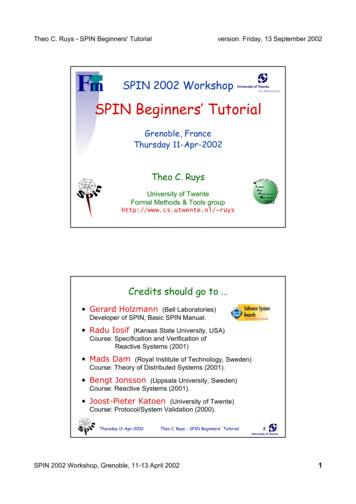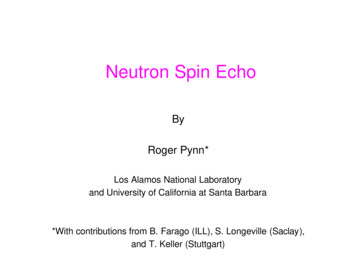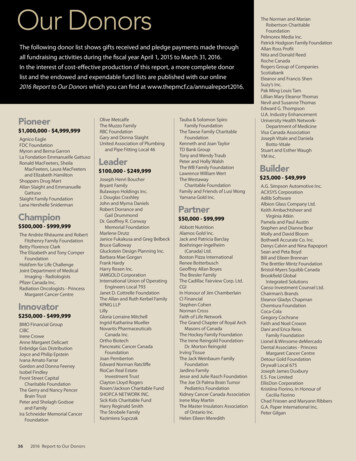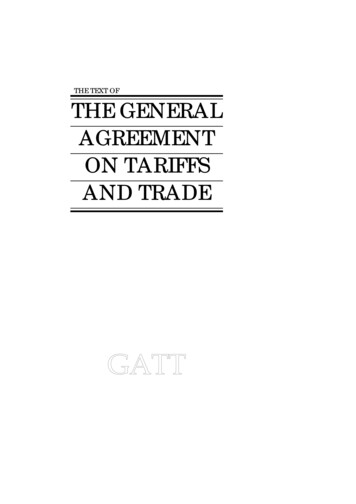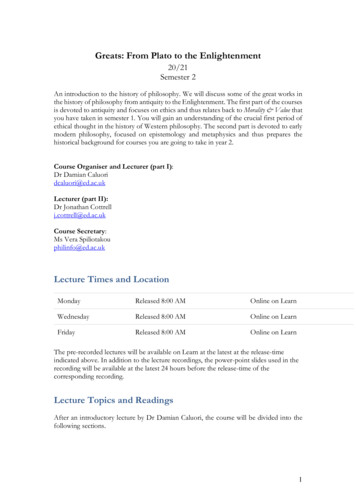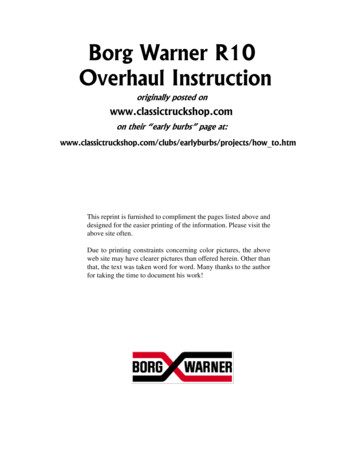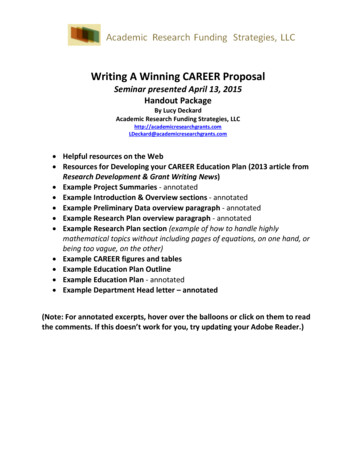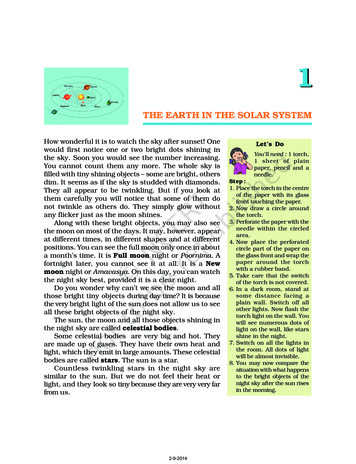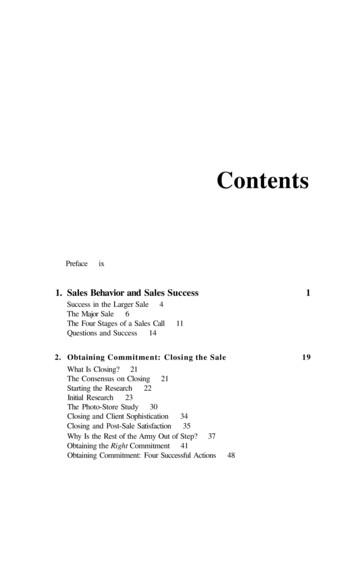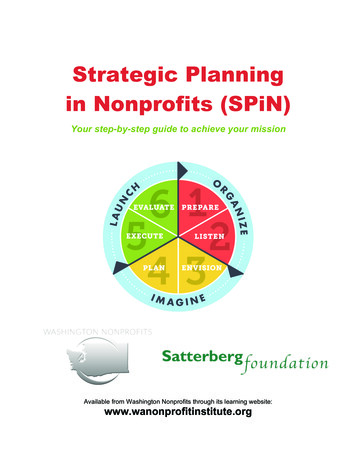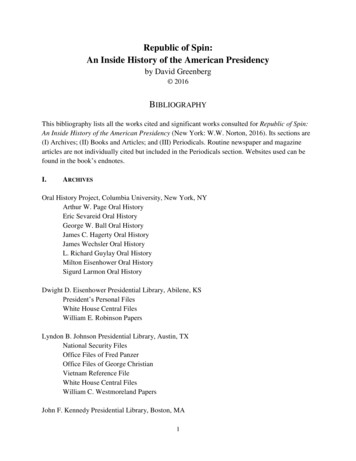
Transcription
Republic of Spin:An Inside History of the American Presidencyby David Greenberg 2016BIBLIOGRAPHYThis bibliography lists all the works cited and significant works consulted for Republic of Spin:An Inside History of the American Presidency (New York: W.W. Norton, 2016). Its sections are(I) Archives; (II) Books and Articles; and (III) Periodicals. Routine newspaper and magazinearticles are not individually cited but included in the Periodicals section. Websites used can befound in the book’s endnotes.I.ARCHIVESOral History Project, Columbia University, New York, NYArthur W. Page Oral HistoryEric Sevareid Oral HistoryGeorge W. Ball Oral HistoryJames C. Hagerty Oral HistoryJames Wechsler Oral HistoryL. Richard Guylay Oral HistoryMilton Eisenhower Oral HistorySigurd Larmon Oral HistoryDwight D. Eisenhower Presidential Library, Abilene, KSPresident’s Personal FilesWhite House Central FilesWilliam E. Robinson PapersLyndon B. Johnson Presidential Library, Austin, TXNational Security FilesOffice Files of Fred PanzerOffice Files of George ChristianVietnam Reference FileWhite House Central FilesWilliam C. Westmoreland PapersJohn F. Kennedy Presidential Library, Boston, MA1
Frank Stanton Oral HistoryJohn F. Kennedy, Pre-Presidential PapersPierre E. G. Salinger Oral HistoryPierre E. G. Salinger Papers, White House Staff FilesRobert F. Kennedy Papers, Political FilesLibrary of Congress, Washington, DCArchibald MacLeish PapersCalvin Coolidge PapersDaniel J. Boorstin PapersEdward L. Bernays PapersEdward T. Clark PapersGeorge B. Cortelyou PapersGeorge Creel PapersGeorge H. Gallup PapersHannah Arendt PapersJames A. Farley PapersJoseph Alsop and Stewart Alsop PapersMotion Picture, Broadcasting, And Recorded Sound DivisionRaymond Clapper PapersRobert Woolley PapersTheodore Roosevelt PapersNew York Public Library, New York, NYInstitute for Propaganda Analysis PapersRichard M. Nixon Presidential Library, Yorba Linda, CARichard Nixon Pre-Presidential SeriesMudd Manuscript Library, Princeton University, Princeton, NJAdlai E. Stevenson PapersArthur Krock PapersIvy Ledbetter Lee PapersRay Stannard Baker PapersFranklin Delano Roosevelt Presidential Library, Hyde Park, NYArchibald MacLeish PapersEmil Hurja PapersFDR-Official FilesFDR-President’s Personal Files2
Harry Hopkins PapersSamuel I. Rosenman PapersHarry S. Truman Presidential Library, Independence, MOJ. Leonard Reinsch Oral HistoryState Historical Society of Wisconsin, Madison, WIBruce Barton PapersRosser Reeves PapersSterling Library, Yale University, New Haven, CTHarold Lasswell PapersWalter Lippmann PapersII.BOOKS AND ARTICLES(INCLUDING DISSERTATIONS AND OTHER UNPUBLISHED MANUSCRIPTS)Abbot, Willis John. Watching the World Go By. Boston: Little, Brown, 1934.Adatto, Kiku. Picture Perfect: Life in the Age of the Photo Op. Princeton: Princeton UniversityPress, 2008 [1993].Alexander, Jeffrey. The Performance of Politics: Obama’s Victory and the Democratic Strugglefor Power. New York: Oxford University Press, 2010.Alger, George. “The Literature of Exposure.” Atlantic Monthly, August 1905, 210-13.Allen, Craig. Eisenhower and the Mass Media: Peace, Prosperity, & Prime-Time TV. ChapelHill: University of North Carolina Press, 1993. “News Conferences on TV: Ike-Age Politics Revisited.” Journalism Quarterly 70:1(March 1993), 13-25. “Robert Montgomery Presents: Hollywood Debut in the Eisenhower White House.”Journal of Broadcasting and Electronic Media 35:4 (Fall 1991), 431-48.Allen, Danielle. Talking to Strangers: Anxieties of Citizenship Since Brown v. Board ofEducation. Chicago: University of Chicago Press, 2004.Allen, Frederick Lewis. Only Yesterday: An Informal History of the Nineteen-Twenties. NewYork: Perennial Classics, 2000 [1931].3
Alsop, Stewart. “The Mystery of Richard Nixon.” Saturday Evening Post, July 12, 1958, 28-72. “Uncle Lyndon.” Saturday Evening Post, October 24, 1964, 16.and Charles Bartlett. “In Time of Crisis.” Saturday Evening Post, December 18, 1962,15-21.Alter, Jonathan. The Defining Moment: FDR’s Hundred Days and the Triumph of Hope. NewYork: Simon & Schuster, 2006.Alterman, Eric. Sound and Fury: The Making of the Punditocracy. Ithaca, NY: CornellUniversity Press, 1999 [1992]. What Liberal Media?: The Truth About Bias and the News. New York: Basic Books,2008. When Presidents Lie: A History of Official Deception and Its Consequences. NewYork: Viking, 2004.Altschuler, Bruce. LBJ and the Polls. Gainesville, FL: University Press of Florida, 1990.Ambrose, Stephen. Nixon. 3 vols. New York: Simon & Schuster, 1987-91.Anderson, Paul Y. “Hoover and the Press.” The Nation, October 14, 1931, 383-84.Arendt, Hannah. “Lying in Politics: Reflections on the Pentagon Papers.” New York Review ofBooks, November 18, 1971, 30-39. The Portable Hannah Arendt, ed. Peter Baehr. New York: Penguin Books, 2000.Aristotle. Rhetoric, trans. W. Rhys Roberts. Mineola, NY: Dover Publications, 2004.Arthur, Anthony. Radical Innocent: Upton Sinclair. New York: Random House, 2006.Ascoli, Max. “Intermezzo.” The Reporter, November 10, 1960, 18.Auden, W.H. The English Auden: Poems, Essays and Dramatic Writings, 1927-1939, ed.Edward Mendelson. London: Faber & Faber, 1977.Auerbach, Jonathan. “McKinley at Home.” American Quarterly 51:4 (December 1999), 797832.4
Auletta, Ken. “Fortress Bush: How the White House Keeps the Press Under Control.” NewYorker, January 19, 2004, 53-65. “Non-Stop News.” New Yorker, January 25, 2010, 38-47.“Authentic Voice.” Time, January 27, 1958, 18-25.Bai, Matt. The Argument: Billionaires, Bloggers, and the Battle to Remake Democratic Politics.New York: Penguin Books, 2007. “The Framing Wars,” New York Times Magazine, July 17, 2005.Baillie, Hugh. High Tension: The Recollections of Hugh Baillie. New York: Harper & Bros.,1959.Baker, Newton. “Why We Went to War.” Foreign Affairs, October 1936, 61-69.Baker, Peter. “The Education of a President.” New York Times Magazine, Oct. 12, 2010, 40-49.Baker, Ray Stannard. American Chronicle: The Autobiography of Ray Stannard Baker. NewYork: Charles Scribner’s Sons, 1945. “Railroads on Trial III: The Private Car and the Beef Trust.” McClure’s, January1906, 318-31. “Railroads on Trial V: How Railroads Make Public Opinion.” McClure’s, March1906, 535-49. “Theodore Roosevelt: A Character Sketch.” McClure’s, November 1898, 23-32. Woodrow Wilson: His Life and Letters. 8 vols. Garden City, NY: Doubleday, Page &Co., 1927-39.Baker, Russell. The Good Times. New York: William Morrow, 1989.Baldwin, Hanson. “Managed News: Our Peacetime Censorship.” Atlantic Monthly, April 1963,53-59.Ball, George W. The Past Has Another Pattern: Memoirs. New York: W.W. Norton, 1982.5
Balogh, Brian. “Mirrors of Desires: Interest Groups, Elections, and the Targeted Style inTwentieth-Century America.” In Meg Jacobs, William Novak, and Julian Zelizer, eds., TheDemocratic Experiment: New Directions in American Political History. Princeton: PrincetonUniversity Press, 2003.Bannister, Robert C. Ray Stannard Baker: The Mind and Thought of a Progressive. New Haven,CT: Yale University Press, 1966.Barclay, Thomas. “The Bureau of Publicity of the Democratic National Committee, 1930-1932,”American Political Science Review, 27:1 (February 1933), 63-65.Barenblatt, Lloyd. Review of The Hidden Persuaders, by Vance Packard. Public OpinionQuarterly 22:4 (Winter 1958-59), 579-580.Baritz, Loren. “Of Time and the Ostrich.” The Nation, January 28, 1961, 82-83.Barkan, Ilyse. “Industry Invites Regulation: The Passage of the Pure Food and Drug Act of1906.” American Journal of Public Health 75:1 (January 1985), 18–26.Barkin, Steve. “Eisenhower’s Secret Strategy: Television Planning in the 1952 Campaign.”Journal of Advertising History, 9:1 (December 1986).Barnouw, Erik. Documentary: A History of the Non-Fiction Film. New York: Oxford UniversityPress, 1974. A History of Broadcasting in the United States. 3 vols. New York: Oxford UniversityPress, 1966-70.Barry, David. Forty Years in Washington. Boston: Little, Brown, 1924. “The Loyalty of the Senate.” New England Magazine, October 1906, 137-48. “News-Getting at the Capital.” The Chautauquan, December 1897, 282-86.Barry, John. Rising Tide: The Great Mississippi Flood of 1927 and How It Changed America.New York: Simon & Schuster, 1997.Barth, Alan. “The Bureau of Intelligence.” Public Opinion Quarterly 7:1 (Spring 1943), 66-76.Barton, Bruce. The Man Nobody Knows: A Discovery of the Real Jesus. Indianapolis: BobbsMerrill, 1925.6
. “This Magic Called Radio; What Will It Mean in Your Home in the Next TenYears?” American Magazine, June 1922, 11-13.Bates, Stephen, and Edwin Diamond. The Spot: The Rise of Political Advertising on Television.Rev. ed. Cambridge, MA: MIT Press, 1988 [1984].Bauer, Raymond A. “Brainwashing: Psychology or Demonology?” Journal of Social Issues 13:3(Summer 1957), 41-47. “Limits of Persuasion: The Hidden Persuaders Are Made of Straw.” HarvardBusiness Review 36:5 (September-October 1958), 105-10. “N 1 Ways Not to Run a Railroad.” American Psychologist 15:10 (October 1960),650-655.Baus, Herbert M. Public Relations at Work. New York: Harper & Bros, 1948.Baylen, Joseph, and Jane Weyant. “Vasili Vereshchagin in the United States.” Russian Review30:1 (July 1971), 250-59.Bean, Walton. “George Creel and His Critics: A Study of the Attacks on the Committee onPublic Information.” PhD diss., University of California at Berkeley, 1941.Becker, Samuel. “Presidential Power: The Influence of Broadcasting.” Quarterly Journal ofSpeech 47:1 (February 1961), 10-18.Beer, Thomas. Hanna. New York: Alfred A. Knopf, 1929.Bellow, Saul. It All Adds Up: From the Dim Past to the Uncertain Future. New York: Viking,1994.Belmonte, Laura A. Selling the American Way: U.S. Propaganda and the Cold War.Philadelphia: University of Pennsylvania Press, 2008.Benco, Nancy L. “Archibald MacLeish: The Poet Librarian.” Quarterly Journal of the Library ofCongress 33:3 (July 1976), 233-49.Bendiner, Robert. “How Much Has TV Changed Campaigning?” New York Times Magazine,November 2, 1952, 13.Benedict, Roswell Alphonso. Malefactors of Great Wealth. New York: American BusinessBureau, 1907.7
Bennett, William. The Death of Outrage: Bill Clinton and the Assault on American Ideals. NewYork: Free Press, 1998.Benson, Lee, Kevin Clancy, and John Kushma. “The Tricks of the Trade.” The Nation,November 30, 1974, 553-58.Benson, Thomas. Writing JFK: Presidential Rhetoric and the Press in the Bay of Pigs Crisis.College Station, TX: Texas A&M University Press, 2004.Bent, Silas. “The Art of Ballyhoo.” Harper’s Monthly, September 1927, 485-94. Ballyhoo: The Voice of the Press. New York: Boni & Liveright, 1927. “Ivy Lee: Minnesinger to Millionaires.” New Republic, November 20, 1929, 369-72.Berger, Maurice. For All the World to See: Visual Culture and the Struggle for Civil Rights. NewHaven, CT: Yale University Press, 2010.Berkman, Dave. “Politics and Radio in the 1924 Campaign.” Journalism Quarterly 64:2-3(Summer-Fall 1987), 422-28.Berlin, Isaiah. “Two Concepts of Liberty,” Michael J. Sandel, ed. In Liberalism and Its Critics,New York: New York University Press, 1984.Bernays, Edward L. “Attitude Polls—Servants or Masters?” Public Opinion Quarterly 9:3(Autumn 1945), 264-68. Biography of an Idea: Memoirs of a Public Relations Counsel. New York: Simon &Schuster, 1965. Crystallizing Public Opinion. New York: Boni & Liveright, 1923. Propaganda, intro. by Mark Crispin Miller. Brooklyn, NY: Ig Publishing, 2005[1928]. “Public Opinion and Public Relations.” Market Research 8:2 (February 1938), 11-14. Speak Up for Democracy. New York: Viking Press, 1940.Bernhard, Nancy E. U.S. Television News and Cold War Propaganda, 1947-1960. New York:Cambridge University Press, 1999.8
Biderman, Albert D. “The Image of ‘Brainwashing.’” Public Opinion Quarterly 26:4 (Winter1962), 547-563.Bingham, Worth, and Ward S. Just. “The President and the Press.” The Reporter, April 12, 1962,18-23.Bishop, Robert L. “Bruce Barton—Presidential Stage Manager.” Journalism Quarterly 43:1(March 1966), 85-89.Bitzer, G. W. Billy Bitzer: His Story. New York: Farrar, Straus & Giroux, 1973.Black, Henry Campbell. The Relation of the Executive Power to Legislation. Princeton:Princeton University Press, 1919.Blair, John L. “Coolidge the Image-Maker: The President and the Press, 1923-1929.” NewEngland Quarterly 46:4 (December 1973), 499-522.Blankenhorn, Heber. “The War of Morale: How America ‘Shelled’ the German Lines withPaper.” Harper’s Monthly, September 1919, 510-24.Blankenship, Albert B. “Public Opinion Polls: A Symposium.” Journal of Marketing 5:2(October 1940), 110-113.Bliven, Bruce. “The Great Coolidge Mystery.” Harper’s Monthly, December 1925, 45-53. “Politics and TV.” Harper’s Monthly, November 1952, 27-33.Bloom, Melvyn. Public Relations and Presidential Campaigns: A Crisis in Democracy. NewYork: Thomas Crowell, 1973.Bloomfield, Douglas. “Joe Tumulty and the Press.” Journalism Quarterly 42:3 (Summer 1965),413-21.Blum, John Morton. Joe Tumulty and the Wilson Era. Boston: Houghton Mifflin, 1951. Liberty, Justice, Order: Essays on Past Politics. New York: W. W. Norton, 1993. The Republican Roosevelt. New York: Atheneum, 1962. V Was for Victory: Politics and American Culture During World War II. New York:Harcourt Brace Jovanovich, 1976.9
. Woodrow Wilson and the Politics of Morality. Boston: Little, Brown, 1956.Blumenthal, Sidney. The Permanent Campaign. New York: Simon & Schuster, 1982. Pledging Allegiance: The Last Campaign of the Cold War. New York: HarperCollins,1990. The Rise of the Counter-Establishment: From Conservative Ideology to PoliticalPower. New York: Harper & Row, 1986. “The Syndicated Presidency.” New Yorker, April 5, 1993, 42-47.Boal, Sam. “Robert Montgomery Presents.” Coronet, September 1954, 83-90.Boorstin, Daniel. The Image: A Guide to Pseudo-Events in America. New York: Vintage Books,1992 [1961]. “Selling the President to the Public.” Commentary, November 1955, 421-27.Bormann, Ernest. “Huey Long: Analysis of a Demagogue.” Today’s Speech, 2:3 (September1954), 16-20.Bourne, Randolph. The Radical Will: Selected Writings, 1911-1918, ed. Olaf Hansen. New York:Urizen Books, 1977.Boutin, Paul. “President Obama’s New Twitter Feed.” NYTimes.com, May 1, 2009.Bowen, Walter, and Henry E. Neal. The United States Secret Service. Philadelphia: ChiltonCompany, 1960.Boyer, Paul. By the Bomb’s Early Light: American Thought and Culture at the Dawn of theAtomic Age. Chapel Hill: University of North Carolina Press, 1994 [1985]. “From Activism to Apathy: The American People and Nuclear Weapons, 19631980.” Journal of American History 70:4 (March 1984), 821-844.Brady, Henry E., and Richard Johnston, eds. Capturing Campaign Effects. Ann Arbor, MI:University of Michigan Press, 2006.Bradlee, Benjamin. Conversations with Kennedy. New York: Pocket Books, 1976 [1975].10
. A Good Life: Newspapering and Other Adventures. New York: Simon & Schuster,1995.Braeman, John, Robert Hamlett Bremner, and Everett Walters, eds. Change and Continuity inTwentieth-Century America. Columbus, OH: Ohio State University Press, 1964.Brailsford, Ian. “‘Madison Avenue Puts on Its Best Hair Shirt’: U.S. Advertising and Its SocialCritics.” International Journal of Advertising 17:3 (August 1998), 365-380.Branch, Taylor. Parting the Waters: America in the King Years, 1954-1963. New York: Simon& Schuster, 1988.Brandeis, Louis Dembitz. Other People’s Money: And How the Bankers Use It. New York: F.A.Stokes, 1914., and Samuel Warren. “The Right to Privacy.” Harvard Law Review 4:5 (December 15,1890), 193–220.Brands, H. W. “C. D. Jackson: Psychological Warriors Never Die,” in Cold Warriors:Eisenhower’s Generation and American Foreign Policy. New York: Columbia University Press,1988.Braudy, Leo. The Frenzy of Renown: Fame & Its History. New York: Oxford University Press,1996.Brigance, William Norwood, ed. History and Criticism of American Public Address. Vol. 2. NewYork: Russell & Russell, 1960.Brill, Steven. “Jimmy Carter’s Pathetic Lies.” Harper’s Monthly, March 1976, 77-88. “Pressgate.” Brill’s Content, August 1998, 122-51.Brinkley, Alan. Voices of Protest: Huey Long, Father Coughlin, and the Great Depression. NewYork: Alfred A. Knopf, 1982.Brinkley, Douglas. The Boys of Pointe du Hoc: Ronald Reagan, D-Day and the U.S. Army 2ndRanger Battalion. New York: William Morrow, 2005.Brodie, Fawn. Richard Nixon: The Shaping of His Character. New York: W. W. Norton, 1981.Brown, Ames. “President Wilson and Publicity.” Harper’s Weekly, November 1, 1913, 19-21.11
Brown, Charles H. The Correspondents’ War. New York: Charles Scribner’s Sons, 1967.Brown, Robert E. “The Myth of Symmetry: Public Relations as Cultural Styles.” PublicRelations Review 32:3 (September 2006), 206–12. “St. Paul as a Public Relations Practitioner: A Meta-Theoretical Speculation onMessianic Communication and Symmetry.” Public Relations Review 29:1 (March 2003), 1–12.Brown, Robert J. Manipulating the Ether: The Power of Broadcast Radio in Thirties America.Jefferson, NC: McFarland & Co., 1998.Brownell, Kathryn Cramer. “Showbiz Politics: Hollywood in American Politics.” PhD diss.,Boston University, 2013.Kevin Brownlow. The War, the West and the Wilderness. New York: Alfred A. Knopf, 1979.Brownlow, Louis. The Autobiography of Louis Brownlow: A Passion for Politics. Vol. 1.Chicago: University of Chicago Press, 1955.Bryce, James. The American Commonwealth. 2nd ed. New York: Macmillan, 1891. Modern Democracies. Vol. 1. New York: Macmillan, 1921.Bryson, Maurice C. “The Literary Digest Poll: Making of a Statistical Myth.” AmericanStatistician 30:4 (November 1976), 184-85.Buckley, Kerry W. “The Man Nobody Knew: Bruce Barton and the Construction of CalvinCoolidge.” A Place Called Paradise: Culture and Community in Northampton, Massachusetts,1654-2004. In Kerry W. Buckley, ed. Amherst, MA: University of Massachusetts Press, 2004. “A President for the ‘Great Silent Majority’: Bruce Barton’s Construction of CalvinCoolidge.” New England Quarterly 76:4 (December 2003), 593-626.Buhite, Russell D., and David W. Levy. FDR’s Fireside Chats. Norman, OK: University ofOklahoma Press, 1992.Bullard, Arthur. Mobilising America. New York: Macmillan, 1917.Burdick, Eugene. The Ninth Wave. Boston: Houghton Mifflin, 1956.Burns, James MacGregor. Roosevelt: The Soldier of Freedom. New York: Harcourt BraceJovanovich, 1970.12
Califano, Joseph, Jr. The Triumph & Tragedy of Lyndon Johnson: The White House Years. NewYork: Simon & Schuster, 1991.Campbell, Joseph W. Getting It Wrong: Ten of the Greatest Misreported Stories in AmericanJournalism. Berkeley: University of California Press, 2010.Cannon, James M. Politics U.S.A.: A Practical Guide to the Winning of Public Office. GardenCity, NY: Doubleday, 1960.Cannon, Lou. President Reagan: The Role of a Lifetime. New York: Simon & Schuster, 1992.Cantril, Albert H. “Hadley Cantril: Perception, Polling, and Policy Research.” Society 44:3(March-April 2007), 65-72.Cantril, Hadley. “America Faces the War: A Study in Public Opinion.” Public Opinion Quarterly4:3 (September 1940), 387-407. The Human Dimension: Experiences in Policy Research. New Brunswick, NJ:Rutgers University Press, 1967. The Invasion from Mars: A Study in the Psychology of Panic. Princeton:Princeton University Press, 1940., and Gordon Allport. The Psychology of Radio. New York: Harper & Bros, 1935.Capozzola, Christopher. Uncle Sam Wants You: World War I and the Making of the ModernAmerican Citizen. New York: Oxford University Press, 2008.Carnes, Mark, ed. The Columbia History of Post-World War II America. New York: ColumbiaUniversity Press, 2007.Caro, Robert. The Years of Lyndon Johnson. 4 vols. New York: Alfred A. Knopf, 1982-2012.Carroll, Gordon. “Dr. Roosevelt’s Propaganda Trust.” American Mercury, September 1937, 131.Carroll, Raymond L. “Harry S. Truman’s 1948 Election: The Inadvertent Broadcast Campaign.”Journal of Broadcasting & Electronic Media 31:2 (Spring 1987), 119-132. “The 1948 Truman Campaign: The Threshold of the Modern Era.” Journal ofBroadcasting 24:2 (Spring 1980), 173-88.13
Carter, Dan. “Good Copy: George Wallace Understood that the Media Thrived onConfrontation.” Media Studies Journal 12:3 (Fall 1998), 40-47. The Politics of Rage: George Wallace, The Origins of the New Conservatism, andthe Transformation of American Politics. New York: Simon & Schuster, 1995.Carwardine, Richard. “Abraham Lincoln and the Fourth Estate: The White House and the PressDuring the American Civil War.” American Nineteenth-Century History 7:1 (March 2006), 1-27.Casey, Steven. Cautious Crusade: Franklin D. Roosevelt, American Public Opinion, and theWar Against Nazi Germany. New York: Oxford University Press, 2001.Cater, Douglass. The Fourth Branch of Government. New York: Vintage Books, 1965 [1959]. “How a President Helps Form Public Opinion.” New York Times Magazine,February 26, 1961, 38. “Who Is Nixon, What Is He?” The Reporter, November 27, 1958, 10.Catledge, Turner. My Life and the Times. New York: Harper & Row. 1971.Ceaser, James, et al. “The Rise of the Rhetorical Presidency.” Presidential Studies Quarterly11:2 (Spring 1981), 158–71.Chafe, William. The Unfinished Journey: America Since World War II, 3rd ed. New York:Oxford University Press, 1995.Chaudhary, Arun. First Cameraman: Documenting the Obama Presidency in Real Time. NewYork: Times Books, 2012.Chernow, Ron. Titan: The Life of John D. Rockefeller, Sr. New York: Random House, 1998.Chernus, Ira. Eisenhower’s Atoms for Peace. College Station, TX: Texas A&M University Press,2002.Chester, Edward W. Radio, Television, and American Politics. New York: Sheed & Ward, 1969.Clinton, Bill. My Life. New York: Alfred A. Knopf, 2004.Cmiel, Kenneth. Democratic Eloquence: The Fight for Popular Speech in Nineteenth-CenturyAmerica. Berkeley: University of California Press, 1991.14
. “On Cynicism, Evil, and the Discovery of Communication in the 1940s.” Journal ofCommunication 46:3 (Summer 1996), 87-88.Cobb, Frank. “The Press and Public Opinion.” New Republic, December 31, 1919, 144-47.Cogley, John. “The Presidential Image.” New Republic, April 10, 1961, 29-31.Coleman, David. The Fourteenth Day: JFK and the Aftermath of the Cuban Missile Crisis. NewYork: W. W. Norton, 2012.Colford, Paul D. The Rush Limbaugh Story: Talent on Loan from God. New York: St. Martin’sPress, 1993.Collins, Gail. Scorpion Tongues: Gossip, Celebrity, and American Politics. New York: WilliamMorrow, 1998.Commager, Henry S. “Washington Would Have Lost a TV Debate.” New York Times Magazine,October 30, 1960, 13.Condon, Richard. The Manchurian Candidate. New York: McGraw-Hill, 1959.Cone, Stacey. “Presuming a Right to Deceive: Radio Free Europe, Radio Liberty, the CIA andthe News Media.” Journalism History 24:4 (Winter 1998-99), 148-55.Converse, Jean M. Survey Research in the United States: Roots and Emergence, 1890-1960.Berkeley: University of California Press, 1987.Conway, Mike. “Before the Bloggers: The Upstart News Technology of Television at the 1948Political Conventions.” American Journalism 24:1 (Winter 2007), 33-58.Cook, Blanche Wiesen. “First Comes the Lie: C. D. Jackson and Political Warfare.” RadicalHistory Review 31 (December 1984), 42-70.Coolidge, Calvin. Autobiography. New York: Cosmopolitan Book Corp., 1929. The Mind of the President, as Revealed by Himself in his Own Words, ed. C. BascomSlemp. Garden City, NY: Doubleday, Page & Co., 1926.Cooper, John Milton. Breaking the Heart of the World: Woodrow Wilson and the Fight for theLeague of Nations. New York: Cambridge University Press, 2001.15
. Walter Hines Page: The Southerner as American, 1855-1918. Chapel Hill: Universityof North Carolina Press, 1977. The Warrior and the Priest: Woodrow Wilson and Theodore Roosevelt. Cambridge,MA: Harvard University Press, 1983. Woodrow Wilson: A Biography. New York: Alfred A. Knopf, 2009.Cordery, Stacy A. Alice: Alice Roosevelt Longworth, from White House Princess to WashingtonPower Broker. New York: Viking, 2007.Cornwell, Elmer E., Jr. “Coolidge and Presidential Leadership.” Public Opinion Quarterly 21:2(Summer 1957), 265-78. Presidential Leadership of Public Opinion. Bloomington: Indiana University Press,1965. “The Presidential Press Conference: A Study in Institutionalization.” MidwestJournal of Political Science 4:4 (November 1960), 370-89. “The Press Conferences of Woodrow Wilson.” Journalism & Mass CommunicationQuarterly 39:3 (September 1962), 292-300. “Wilson, Creel, and the Presidency.” Public Opinion Quarterly 23:2 (Summer 1959),197–98.Cotler, Gordon. “That Plague of Spots from Madison Avenue.” The Reporter, November 25,1952, 7-9.Cousins, Norman. “Presidents Don’t Have to Be Quiz Champions.” Saturday Review, November5, 1960, 34.Cowley, Malcolm. “Poets and Prophets.” New Republic, May 5, 1941, 640. “The Sorrows of Elmer Davis.” New Republic, May 3, 1943, 591-93.Craig, Douglas. Fireside Politics: Radio and Political Culture in the United States, 1920-1940.Baltimore: Johns Hopkins University Press, 2000.Creel, George. How We Advertised America: The First Telling of the Amazing Story of theCommittee on Public Information That Carried the Gospel of Americanism to Every Corner ofthe Globe. New York: Harper & Bros., 1920.16
. “The ‘Lash’ of Public Opinion.” Collier’s, November 22, 1924, 46. “The Next Four Years: An Interview with the President.” Everybody’s, February1917, 129-39. “Poisoners of Public Opinion.” Harper’s Weekly, November 7, 1914, 436-38. Rebel at Large: Recollections of Fifty Crowded Years. New York: G. P. Putnam’sSons, 1947. “What Roosevelt Intends to Do.” Collier’s, March 11, 1933, 7-9, 34-36.Creelman, James. “A Defender of the Senate.” Pearson’s Magazine, June 1906, 622-29. “Mr. Cortelyou Explains President McKinley.” Pearson’s Magazine, June 1908, 56985.Croly, Herbert. The Promise of American Life. New York: Macmillan, 1909. “Unregenerate Democracy.” New Republic, February 5, 1916, 17-19.Crouse, Timothy. Boys on the Bus. New York: Ballantine Books, 1973 [1972].Cruikshank, Jeffrey L., and Arthur W. Schultz. The Man Who Sold America: The Amazing (ButTrue!) Story of Albert D. Lasker and the Creation of the Advertising Century. Boston: HarvardBusiness Press, 2010.Cull, Nicholas J. The Cold War and the United States Information Agency: AmericanPropaganda and Public Diplomacy, 1945-1989. New York: Cambridge University Press, 2008.Cutlip, Scott. “The Nation’s First Public Relations Firm.” Journalism Quarterly 43:3 (Summer1966), 269–80. “Public Relations and the American Revolution.” Public Relations Review 2:4(Winter 1976), 11–24. Public Relations History: From the 17th to the 20th Century: The Antecedents.New York: Routledge, 2013. The Unseen Power: Public Relations, a History. Hillsdale, NJ: Lawrence Erlbaum,1994.17
Crick, Bernard. In Defence of Politics. 4th ed. Chicago: University of Chicago Press, 1992[1962].Czitrom, Daniel J. Media and the American Mind: From Morse to McLuhan. Chapel Hill:University of North Carolina Press, 1982.Dallek, Robert. Flawed Giant: Lyndon Johnson and His Times, 1961-1973. New York: OxfordUniversity Press, 1998. Franklin D. Roosevelt and American Foreign Policy, 1932-1945. New York:Oxford University Press, 1979. An Unfinished Life: John F. Kennedy, 1917-1963. Boston: Little, Brown, 2003.Daniel, Clifton Truman. “Adventures with Grandpa Truman.” Prologue, Spring 2009, 36-41.Daniels, Josephus. The Wilson Era: Years of Peace. Chapel Hill: University of North CarolinaPress, 1944.Davies, David. The Postwar Decline of American Newspapers, 1945-1965. Westport, CT:Praeger Publishers, 2006.Davis, Oscar King. “The Game and Cost of Making a President.” New York Times Magazine,August 9, 1908, SM2. Released for Publication. Some Inside Political History of Theodore Rooseveltand His Times, 1898-1918. Boston: Houghton Mifflin, 1925.Davison, W. Phillips. “Public Opinion,” ed. by David L. Sills. International Encyclopedia of theSocial Sciences. New York: Macmillan, 1968. “The Third-Person Effect in Communication.” Public Opinion Quarterly47:1 (Spring 1983), 1-15.Dawes, Charles. Notes as Vice President, 1928-1929. Boston: Little, Brown, 1935.Deakin, James. Straight Stuff: The Reporters, the White House, and the Truth. New York:William Morrow, 1984.Dean, John W. Warren Harding. New York: Times Books, 2004.18
DeBauche, Leslie Midkiff. Reel Patriotism: The Movies and World War I. Madison: Universityof Wisconsin Press, 1997.Demsky, Jeffrey Scott. “Going Public in Support: American Discursive Opposition to Nazi AntiSemitism, 1933-1944.” PhD diss., University of Florida, 2007.DeVoto, Bernard. “The Fallacy of Excess Interpretation.” Harper’s Monthly, June 1938, 109-12.Dewey, John. Individualism Old and New. Amherst, NY: Prometheus Books, 1999 [1930]. “The New Paternalism.” New Republic, December 21, 1918, 216-217. “Practical Democracy, review of The Phantom Republic. New Republic, December 2,1925, 52-54. The Public and Its Problems. Denver: Swallow Books, 1954 [1927]. “Public Opinion.” New Republic, May 3, 1922, 286. “Theodore Roosevelt.” The Dial, February 8, 1919, 115-17. “The University of the Air,” School and Society, December 15, 1934, 805.Dickinson, J.J. “Theodore Roosevelt: Press-Agent.” Harper’s Weekly, September 28, 1907,1410.Didion, Joan. Political Fictions. New York: Alfred A. Knopf, 2001.Dobbs, Michael. The Rise of Political Fact-Checking: How Reagan Inspired a JournalisticMovement: A Reporter’s Eye View. New America Foundation, 2012. Online.Doenecke, Justus D. Nothing Less Than War: A New History of America’s Entry into World WarI. Lexington, KY: University Press of Kentucky, 2011.Doherty, Thomas. Cold War, Cool Medium: Television, McCarthyism, and American Culture.New York: Columbia University Press, 2003.Donald, Aida DiPace. Lion in the White House: A Life of Theodore Roosevelt. New York: BasicBooks, 2007.Donaldson, Scott. Archibald MacLeish: An American Life. Boston: Houghton Miffli
Institute for Propaganda Analysis Papers Richard M. Nixon Presidential Library, Yorba Linda, CA . University of North Carolina Press, 1993. _. "News Conferences on TV: Ike-Age Politics Revisited." Journalism Quarterly 70:1 (March 1993), 13-25. _. "Robert Montgomery Presents: Hollywood Debut in the Eisenhower White House .

